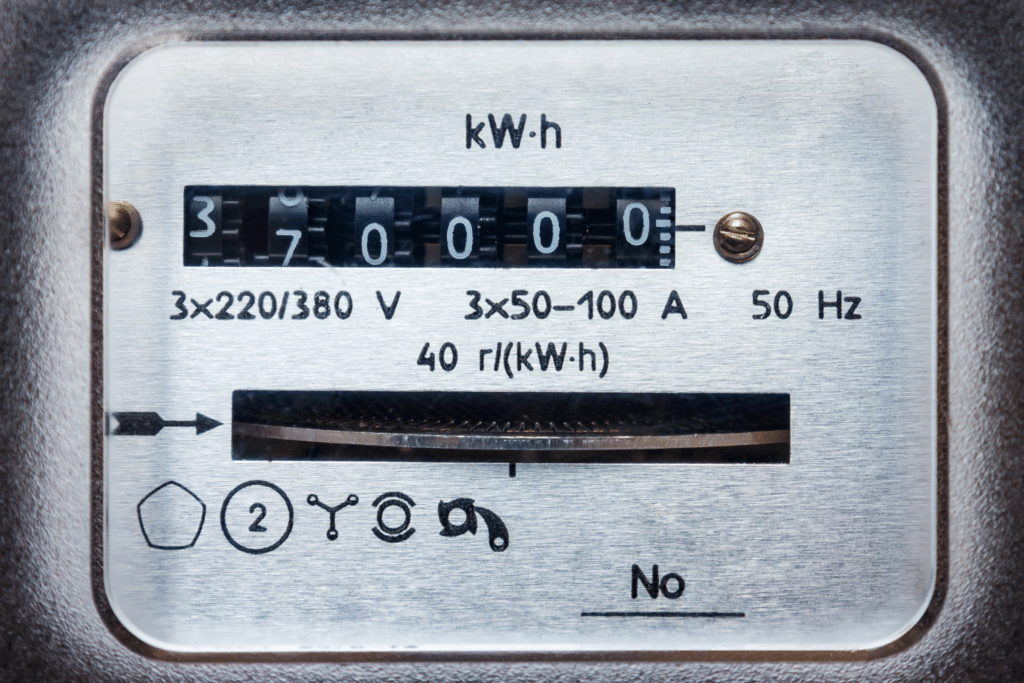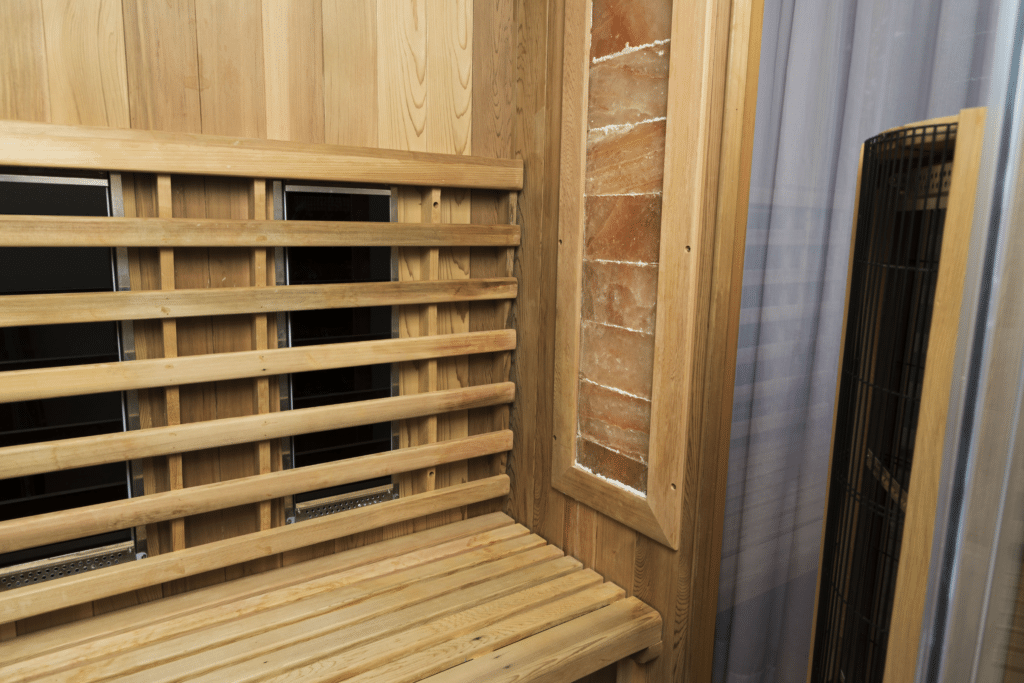Infrared saunas are popular in gyms and other fitness businesses, but they’re also a hot choice for homeowners. If you want to relax after working out, then a sauna should be at the top of your shopping list. However, the cost of electricity might be enough to scare away many potential buyers.
An infrared sauna typically uses between 1000 to 3000 watts of electricity or 1-3 kilowatts per hour. With an average price of 13.31 cents per kilowatt hour (kWh), an infrared sauna costs between $.13-$.40 per hour to operate. The wattage depends on how big the sauna is, what the temperature is set to, how many people are inside, and a few other minor variables. You can use the wattage with your local electricity costs to find out how much you’ll have to spend.
Throughout this article, you’ll also learn the following info about infrared sauna electrical consumption:
- Different factors that contribute to the wattage of an IR sauna
- How you can cut back of the energy consumption
- How much you can expect to spend on your monthly bill
Factors involved with how much electricity and infrared sauna will use
Electrical consumption has all sorts of different factors. Knowing what contributes to your bill will allow you to reduce it, as you’ll see in the next section.
There are 7 main factors to consider when calculating the electricity costs of an infrared sauna:
- Square footage or size of the infrared sauna
- Temperature of the infrared sauna
- The wattage rating for the infrared sauna
- Your cost of electricity
- Sauna session length
- Sauna insulation
- Where the sauna is located (outside vs inside)

Square footage or size of the infrared sauna
The size of the sauna is a major factor in determining the energy consumption. The larger the sauna, the more space it takes to heat up and maintain a consistent temperature.
The most common size for an indoor infrared sauna is around 4.5 feet by 6 feet, with a height of around 6.5 feet, big enough for about 2-3 people.
This means that a larger sauna will use more energy and cost more to run than a smaller sauna. Additionally, the size of the sauna will also affect the number of people who can use it at one time, which can impact the frequency and duration of sauna sessions.
Temperature of the infrared sauna
The temperature of the sauna is another major factor in determining the energy consumption. The higher the temperature of the sauna, the more energy it will require to maintain that temperature.
The recommended temperature for an infrared sauna varies, but generally falls within the range of 110°F to 130°F (43°C to 54°C)
So, if you like your sauna hot, it will cost more to run. However, it’s important to note that higher temperatures are not always better, as excessively high temperatures can be uncomfortable or even dangerous.

The wattage rating for the infrared sauna
The wattage rating of the sauna heater is a measure of the amount of power it consumes.
The typical wattage for an infrared sauna designed for 2-3 people usually ranges from 1200 watts to 2000 watts.
To calculate the energy consumption of your infrared sauna, you need to look at its wattage and convert it into kilowatt-hours. The wattage indicates the power used by the sauna per hour. You can find the wattage of your sauna in its product specifications. To convert it to kilowatt-hours (kWh), divide the wattage by 1000.
For example, if your infrared sauna is rated at 1,500 watts you’ll have 1,500 watts / 1,000 = 1.5 kWh
This means your sauna consumes 1.5 kWh per hour of use.
Saunas with higher wattage ratings will use more energy and cost more to run. However, higher-wattage heaters can also heat up the sauna more quickly, which can be beneficial if you have limited time for sauna sessions.
Your cost of electricity
The cost of electricity varies depending on where you live and can be impacted by factors such as the time of day and season.
According to the U.S. Energy Information Administration (EIA), the average retail price of electricity for residential customers in the United States was 13.31 cents per kilowatt-hour (kWh) as of July 2023.
That means a 1500-watt sauna that uses 1.5 kWh will cost about 13.31 cents per hour to operate. Not bad!

Sauna session length
The length of each sauna session will impact the energy consumption and cost of running the sauna. Longer sessions will use more energy and cost more to run.
The recommended session length for infrared saunas is generally between 20 to 30 minutes per session, but sessions of up to 1 hour are generally considered normal.
However, it’s important to note that frequent shorter sessions may also result in higher overall energy consumption than less frequent longer sessions.
Sauna insulation
Proper insulation can help to reduce heat loss and improve the efficiency of your sauna. A well-insulated sauna will use less energy and cost less to run than a poorly insulated sauna.
Factors that can impact insulation include the quality of the sauna materials, the thickness of the walls, and the presence of any gaps or leaks.
How much electricity does an infrared sauna use? (with costs)
The electricity usage of an infrared sauna can vary based on several factors, such as the size of the sauna, the number of heating elements, and the wattage of those elements.
Here is a useful table summarizing the key information from the article:
| Measure | Formula Used | Example Value | Cost Example (At $0.12 per kWh) | Cost Example (At $0.4 per kWh) |
|---|---|---|---|---|
| Per Hour | Wattage (kW)×Time (hours)Wattage (kW)×Time (hours) | 1.5 kWh | $0.18 | $0.60 |
| Per Day (2 hours) | Per Hour Usage×Hours/DayPer Hour Usage×Hours/Day | 3 kWh | $0.36-$1.20 | $1.20-$3.20 |
| Per Month (40 hours) | Per Hour Usage×Hours/MonthPer Hour Usage×Hours/Month | 60 kWh | $7.8-$24 | $24-$96 |
| Per Year | Monthly Usage×12Monthly Usage×12 | 720 kWh | $93.6-$288 | $288-$960 |
Key Points:
- The per-hour usage was based on a 1,500-watt sauna used for one hour, which equals 1.5 kWh.
- The per-day usage assumes the sauna is used for 2 hours each day.
- The monthly usage assumes 40 hours of use per month.
- The annual usage is simply the monthly usage multiplied by 12.
This table provides a quick reference to understand the costs involved in operating an infrared sauna, and it shows the cost variance depending on the electricity rates ($0.12 per kWh to $0.4 per kWh in the examples).
Here’s a general outline for calculating the electricity usage:
Basic Formula
To calculate the electricity usage of an infrared sauna, you can use the formula:
Electricity Usage (kWh)=Wattage (kW)×Time (hours)Electricity Usage (kWh)=Wattage (kW)×Time (hours)
Note: Wattage is usually provided in watts, so you’ll need to convert it to kilowatts (kW) by dividing by 1,000.
Example
Suppose you have an infrared sauna that uses 1,500 watts (or 1.5 kW when converted) of power. If you use the sauna for one hour, the electricity consumption would be:
Electricity Usage = 1.5 kW×1 hour = 1.5 kWh Electricity Usage = 1.5kW×1hour = 1.5kWh
Points to Consider
- Some saunas might have variable wattage settings or might not use the full wattage all the time due to thermostatic control. In such cases, the actual usage might be less.
- The above example doesn’t include any additional electrical components like sound systems, lighting, or control panels that might also consume electricity.
For a precise figure, you would need to refer to the manufacturer’s specifications and perhaps do some measurements of your own. Always remember to consider the variables affecting consumption, as this will help you get a more accurate understanding of your sauna’s electricity usage.
How much electricity will an infrared sauna use per hour?
You can further calculate the cost by multiplying the electricity usage by your local electricity rate (in $/kWh). For example, if your local electricity rate is $0.12 per kWh, the cost for one hour would be:
Cost per kWh x 1 = Cost for 1 hour

How much electricity will an infrared sauna use per day?
Let’s assume you have an infrared sauna that uses 1,500 watts (or 1.5 kW) of power. If you use it for one hour, the electricity usage would be:
Electricity Usage per Hour = 1.5 kW × 1 hour = 1.5 kWh Electricity Usage per Hour = 1.5kW×1hour = 1.5kWh
If you use the sauna for, say, 2 hours each day, then the daily electricity consumption would be:
Electricity Usage per Day = 1.5 kWh × 2 hours/day = 3 kWh per day or about $.39-$1.20 per day
How much electricity will an infrared sauna use per month?
Let’s assume you have an infrared sauna that uses 1,500 watts (or 1.5 kW) of power. If you use it for one hour, the electricity usage would be:
Electricity Usage per Hour = 1.5 kW × 1 hour = 1.5 kWh Electricity Usage per Hour = 1.5kW×1hour = 1.5kWh
If you use the sauna for, say, 2 hours each day, then the daily electricity consumption would be:
Electricity Usage per Day = 1.5 kWh/hour × 2 hours/day = 3 kWh per day
If you use the sauna for 2 hours each day, 5 days per week, for a month, that’s about 40 hours and the electricity consumption per month would be:
Electricity usage per month = 1.5 kWh x 40 hours = 60 kWh or about $7.8-$24 per month
How much electricity will an infrared sauna use per year?
Now, calculate the annual electricity usage:
Annual Electricity Usage (kWh) = Monthly Electricity Usage (kWh) × 12
Using our example above with a 1500-watt infrared sauna and a 40-hour-per-month usage, we’ll get:
Annual Electricity Usage = 60 kWh per month × 12 months per year = 720 kWh/year
So, a 1,500-watt infrared sauna used for 40 hours per month would use approximately 720 kWh per year or $93.6-$288 per year in electricity cost.
Other costs associated with infrared sauna that you should keep in mind
While infrared saunas are generally low-maintenance, there are some ongoing costs you may encounter aside from electricity. Here’s a breakdown:
Cleaning Supplies
- Cleaning products suitable for the materials your sauna is made of, whether it’s wood, glass, or other.
- Special cleaning agents to remove mineral deposits or stains may be necessary from time to time.

Replacement Parts
- Heating Elements: While they are designed to last for a long time, heating elements can break and may need to be replaced.
- Control Panels/Electronic Components: These can malfunction and may require replacement or repair.
- Bulbs for Infrared Lamps: If your sauna uses incandescent or halogen bulbs, these may need to be replaced periodically.
- Door Seals and Handles: Wear and tear can affect the effectiveness of seals and handles, requiring eventual replacement.
Accessories
- Backrests, Neck Supports, and Towels: These might need replacement due to wear and tear.
- Aromatherapy oils: If you use essential oils in your sauna, this can be a recurring cost.
Professional Servicing
Some owners opt for professional servicing to inspect the unit’s electrical systems, clean hard-to-reach areas, and ensure the sauna is operating efficiently and safely.
Water Usage
If you shower before and after using the sauna (as is generally recommended), this will slightly increase your water usage, though this cost is usually minimal.
Extended Warranty or Service Plans
These can offer peace of mind but come at a premium. They can cover the cost of labor and parts for repairs that may be needed down the line.
Insurance
Some people choose to insure their saunas against potential damages, especially if they are high-end models.
Miscellaneous
- Some infrared saunas come with entertainment systems, so you might consider the cost of subscriptions to music or video streaming services.
- If you use special filters or ionizers to improve air quality inside the sauna, these may need to be replaced periodically.
While not all of these costs will apply to every sauna or owner, they are worth considering when budgeting for the ongoing expenses of maintaining an infrared sauna.
How to reduce the operating costs of an infrared sauna
Reducing the operating costs of an infrared sauna can make it more affordable to enjoy the benefits of regular sessions. Here are some tips to help you cut down on expenses:
Energy Efficiency
- Opt for Energy-Efficient Models: If you’re in the market for a new infrared sauna, look for energy-efficient models that consume less electricity.
- Seal Leaks: Ensure that the sauna is well-sealed to prevent heat loss, which would require more energy to maintain the temperature.
- Preheat Timing: Preheat the sauna for the minimum amount of time needed to reach the desired temperature.
- Optimal Temperature: Lower the temperature settings to the lowest comfortable level to reduce energy consumption.
Smart Usage
- Scheduled Sessions: Use the sauna back-to-back for family members or friends to avoid having to preheat it multiple times.
- Timer Settings: Use a timer to automatically switch off the sauna, avoiding unnecessary energy usage.
- Limit Accessories: Saunas equipped with additional features like sound systems or mood lighting will use more electricity. Use these features sparingly if you’re looking to save on costs.
Maintenance and Repairs
- Regular Cleaning: Regular cleaning can help the heating elements and other components work more efficiently, reducing the need for expensive replacements.
- DIY Repairs: Some minor repairs or replacements may be done at home, reducing the need for professional services.
- Preventive Maintenance: Periodically check for any wear and tear on seals, heating elements, and other components to preemptively address issues before they become major problems.
Utility Costs
- Off-Peak Hours: Some locations have variable electricity rates. Use your sauna during off-peak hours when electricity is cheaper.
- Water Conservation: If you shower before and after, try to be water-efficient to save on water bills.
Additional Tips
- Bulk Purchases: Buy cleaning supplies, aromatherapy oils, and other accessories in bulk to benefit from discounts.
- Group Sessions: If you’re comfortable with it, having more than one person use the sauna at the same time can make more efficient use of the energy consumed.
- Consider a Solar Panel: If you’re interested in a long-term investment, installing a solar panel could help offset some of the electricity costs.
- Track Your Usage: Keep an eye on your energy bills to track how changes in your sauna habits affect your overall consumption.
By taking these steps, you can enjoy the benefits of your infrared sauna while minimizing its operating costs.


